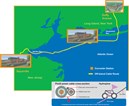New Jersey And Long Island Linked With HVDC Transmission

In the future, the power utility LIPA will use the HVDC connection between New Jersey and Long Island to cover the increased demand for power, especially in the summer months. Siemens is supplying and installing the complete HVDC technology as well as the communication and control equipment. Siemens is also responsible for constructing the valve halls and operations building. The consortium partner Pirelli will supply and lay a total of 105 km of submarine and subterranean cable.
Neptune RTS was established to develop and commercially operate power supply projects in the United States. By delivering a complete package of supply, installation, service and operation from a single source, Siemens is providing seamless coverage for the customer's needs. The availability of this combined expertise fulfills the prerequisites for financing these kinds of complex supply projects through the free investment market. Siemens and Neptune RTS developed the project over three years to prepare it for implementation. In addition to providing technological expertise, studies, and engineering services, Siemens also supported its customer in the project's approval process.
HVDC transmission systems allow quick regulation of load flows, thus contributing to the stability of the connected networks and limiting the effects of disturbances such as blackouts. HVDC is called for whenever conventional alternating current transmission reaches the limits of technological and commercial viability. HVDC technology is used, for example, to connect networks over very long distances or via undersea cables. With energy demand increasing worldwide, high-voltage direct-current transmission will play an increasingly important role as it becomes necessary to tap energy sources far removed from the point of consumption, such is often the case with hydropower stations.

SOURCE: The Siemens Power Transmission and Distribution Group
